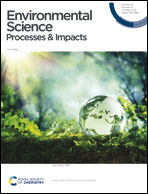The effect of built-in and portable ionizers on in-cabin ozone concentrations in light-duty vehicles†
Abstract
This paper investigates the effects of ionizers on the ozone concentration within vehicle cabins by using a series of measurements combined with a kinetic box model. Testing consisted of measuring ozone concentration during static tests where the ventilation of the test vehicle was turned on and off depending on the test. This testing was repeated for three different portable ionizers and two vehicles with built-in ionizers. Ionizer A produced ozone at a rate of ∼0.04 ppb s−1 (∼0.68 mg h−1), which increased the in-cabin O3 concentrations of a Mitsubishi Mirage to ∼10 ppb with the fan off and ∼6 ppb in the recirculation mode. In the fresh air mode, in-cabin O3 concentrations were dominated by outdoor-to-indoor transport. Ionizer B and C produced O3 at a rate of less than 0.008 ppb s−1 (<0.14 mg h−1); however, during retesting, ionizer C was shown to emit large amounts of ozone for short amounts of time while being tested up close. The same testing was completed on vehicles with built-in ionizers; these produced <0.01 ppb s−1 (<0.32 mg h−1 in the Buick Enclave and <0.25 mg h−1 in the Hyundai Genesis), and in-cabin O3 concentrations were again dominated by outdoor-to-indoor transport with fresh air ventilation. While ionizers are currently regulated, the negative impact they have on in cabin air quality is important to continue monitoring.

- This article is part of the themed collection: Environmental exposure and impacts


 Please wait while we load your content...
Please wait while we load your content...